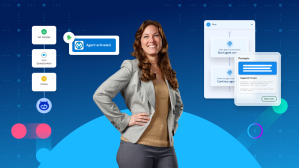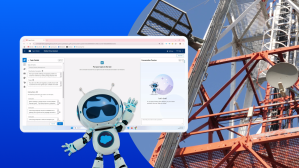San Mateo County Community College District is an incredible example of a Trailblazer that is putting equity and access to education at the center of their mission. Community Colleges are the cornerstone of cities and towns across the country, providing access to quality education and driving social mobility for all types of lifelong learners.
The California Community College System is the largest system of higher education in the country — with more than 2.1 million students at 115 colleges. They’re also the largest provider of workforce training in the nation.
The San Mateo County Community College District is a Bay Area district and member of the CA community college system that is serving more than 25,000 students each day across three campuses.
We spoke with Karrie Mitchell, Vice President of Planning, Research and Institutional Effectiveness from the San Mateo County Community College District about their digital transformation.
Q: Tell us about the San Mateo County Community College District and what makes your district unique.
Our district is focused on two core areas — driving open access for students and being responsive to community needs. This mission is especially important for the students we serve in the Bay Area, where being located in the heart of Silicon Valley has its advantages and disadvantages as a community college district. There’s been an increase in high wage earners coming into the local area and a constraint on low and middle income families being able to afford their basic needs. Our students are facing food and housing insecurity and struggle to have transportation options that are affordable and efficient.
Q: What kind of experience do these students expect on campus when they interact with advisors, career services, etc.?
Students expect to interact with their community college in a similar fashion as they would Amazon or Instagram.
With 66% of our students being part-time, many of them expect a quick and seamless way to get their questions answered even when they aren’t physically on campus. It’s imperative that we provide the digital experiences that make this possible while also providing our faculty and staff with a single view of the student so they can drive those personalized engagements at scale.
Q: What led you to choose Salesforce, and what challenges were you facing before?
It used to take staff eight hours to gather student data and that data was only available on a monthly basis. Previously, counselors would have to go to multiple systems to get information on students, and we didn’t have analytics in the background to put all the information together in a meaningful way. Interdepartmental communication relied on emails and phone calls, but nothing to allow for a comprehensive look at the student experience. Salesforce.org Education Cloud, including the Education Data Architecture (EDA) and Salesforce Advisor Link (SAL), allows us to bring it all together for the Success Team to work collaboratively for the customized needs of the students.
At the same time, students weren’t able to make appointments with counselors and found themselves telling the same story over and over again as they bounced around from various offices. This was seen as one of the contributing factors to the lower graduation rates as students couldn’t get an answer quickly, so they gave up and no one would follow up and try to re-engage them.
Now, Education Cloud will allow us to bring very siloed systems and departments into one platform to help move students forward in their goals.
Q: Community colleges serve a wide range of students — including many who are juggling jobs or childcare on top of school work. How is the district thinking about creating personalized experiences for every type of student in order to help them achieve their completion goals?
We try to work with the students to complete as many credits as they can as soon as they can in order to keep the momentum going towards completing their degree or certificate. The way we go about doing this is by personalizing the experience to the student and meeting them where they’re at, whether that’s full-time or part-time.
As part of our Guided Pathways efforts, our Program Maps may be set up for full-time students, but they can work with their counselors through the use of Salesforce Advisor Link to tailor the plan to their individual needs. If a student needs to take time off to deal with personal matters, we can continue to engage them through the use of Journey Builder in Marketing Cloud to get them back on track when they’re ready again.
When we look at being equity-minded at the district, being able to create those student-customized interventions really supports that mission.
Q: How is Salesforce helping the district report on student outcomes?
SMCCCD is a community supported district, although it has various grant programs associated with performance. Einstein Analytics dashboards will help the district easily display information during board meetings about various demographics in support of the District Strategic Plan. Additionally, leadership can access these dashboards on their mobile device. Now, program staff can easily get the information they need in real-time to measure outcomes and drive student success year after year.
Q: What is the SMCCCD’s Promise Scholars Program and how does Salesforce support the program?
As part of promoting an equity agenda, SMCCCD has committed to replicating the Accelerated Study in Associate Programs (ASAP) program out of the City University of New York (CUNY). The SMCCCD Promise Scholars Program includes removing financial barriers such as those associated with tuition and fees, textbooks, and transportation incentives while providing comprehensive and personalized advising services to program participants. Students attend full-time, have an individualized course schedule, are connected to Promise Scholars Program and have specialized academic support services.
SMCCCD began these efforts over the past year and are excited to have Salesforce as a partner in the program as data, case management and early intervention strategies are key to program success. With the use of Salesforce Advisor Link (SAL), Promise Counselors can monitor student progress and receive alerts through LMS and SMS integrations when students are not doing well in their courses through easily configurable dashboards. Counselors can set-up Success Plans that are customized for each student based on their individual needs and be alerted when students complete (or don’t) items on their plan. Referrals to other members of the Success Team are easy and can provide all the information needed to the team member so the student doesn’t need to re-tell the story of needing food, or financial assistance, or additional tutoring in math. Supervisors and administrators can easily access reports on how students are progressing towards their goals in the aggregate, so that policy and funding decisions can be made more easily and efficiently.
You can find more information on the latest Education Cloud announcements here.




















